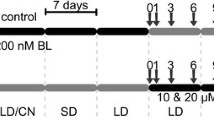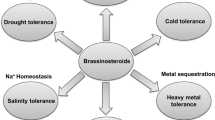Abstract
The objective of this study was to increase our understanding of the relationship between brassinosteroids (BRs) and gibberellins (GAs) by examining the effects of BR deficiency on the GA biosynthesis pathway in several tissue types of pea (Pisum sativum L.). It was suggested recently that, in Arabidopsis, BRs act as positive regulators of GA 20-oxidation, a key step in GA biosynthesis [Bouquin et al. (2001) Plant Physiol 127:450–458]. However, this may not be the case in pea as GA20 levels were consistently higher in all shoot tissues of BR-deficient (lk and lkb) and BR-response (lka) mutants. The application of brassinolide (BL) to lkb plants reduced GA20 levels, and metabolism studies revealed a reduced conversion of GA19 to GA20 in epi-BL-treated lkb plants. These results indicate that BRs actually negatively regulate GA20 levels in pea. Although GA20 levels are affected by BR levels, this does not result in consistent changes in the level of the bioactive GA, GA1. Therefore, even though a clear interaction exists between endogenous BR levels and the level of GA20, this interaction may not be biologically significant. In addition to the effect of BRs on GA levels, the effect of altered GA1 levels on endogenous BR levels was examined. There was no significant difference in BR levels between the GA mutants and the wild type (wt), indicating that altered GA1 levels have no effect on BR levels in pea. It appears that the BR growth response is not mediated by changes in bioactive GA levels, thus providing further evidence that BRs are important regulators of stem elongation.





Similar content being viewed by others
Abbreviations
- IAA:
-
Indole-3-acetic acid
- ABA:
-
Abscisic acid
- BL:
-
Brassinolide
- BR:
-
Brassinosteroid
- CS:
-
Castasterone
- 6-DeoxoCS:
-
6-Deoxocastasterone
- GA:
-
Gibberellin
- GC-MS-SIM:
-
Gas chromatography-mass spectrometry-selected ion monitoring
- HPLC:
-
High performance liquid chromatography
- WT:
-
Wild type
References
Bao F, Shen J, Brady SR, Muday GK, Asami T, Yang Z (2004) Brassinosteroids interact with auxin to promote lateral root development in Arabidopsis. Plant Physiol 134:1624–1631
Bouquin T, Meier C, Foster R, Nielsen ME, Mundy J (2001) Control of specific gene expression by gibberellin and brassinosteroid. Plant Physiol 127:450–458
Clouse SD, Hall AF, Langford M, McMorris TC, Baker ME (1993) Physiological and molecular effects of brassinosteroids on Arabidopsis thaliana. J Plant Growth Regul 12:61–66
Davies PJ (ed) (1995) Plant hormones: physiology, biochemistry and molecular biology, 2nd edn. Kluwer, Dordrecht
Goda H, Shimada Y, Asami T, Fujioka S, Yoshida S (2002) Microarray analysis of brassinosteroid-regulated genes in Arabidopsis. Plant Physiol 130:1319–1334
Goda H, Sawa S, Asami T, Fujioka S, Shimada Y, Yoshida S (2004) Comprehensive comparison of auxin-regulated and brassinosteroid-regulated genes in Arabidopsis. Plant Physiol 134:1555–1573
Grossmann K, Hansen H (2001) Ethylene-triggered abscisic acid: a principle in plant growth regulation. Physiol Plant 113:9–14
Hedden P, Lenton J (1988) Genetic and chemical approaches to the metabolic regulation and mode of action of gibberellins in plants. In: Steffens GL, Rumsey TS (eds) Biomechanisms regulating growth and development, Beltsville symposia in agricultural research. Kluwer, Boston, pp 175–204
Lawrence NL, Ross JJ, Mander LN, Reid JB (1992) Internode length in Pisum. Mutants lk, lka and lkb do not accumulate gibberellins. J Plant Growth Regul 11:35–37
Mandava NB (1988) Plant growth-promoting brassinosteroids. Annu Rev Plant Physiol Plant Mol Biol 39:23–52
McKay MJ, Ross JJ, Lawrence NL, Cramp RE, Beveridge CA, Reid JB (1994) Control of internode length in Pisum sativum. Further evidence for the involvement of indole-3-acetic acid. Plant Physiol 106:1521–1526
Mussig C, Fischer S, Altmann T (2002) Brassinosteroid-regulated gene expression. Plant Physiol 129:1241–1251
Nadhzimov UK, Jupe SC, Jones MG, Scott IM (1988) Growth and gibberellin relations of the extreme dwarf dx tomato mutant. Physiol Plant 73:252–256
Nemhauser JL, Chory J (2004) BRing it on: new insights into the mechanism of brassinosteroid action. J Exp Bot 55:265–270
Nomura T, Nakayama M, Reid JB, Takeuchi Y, Yokota T (1997) Blockage of brassinosteroid biosynthesis and sensitivity causes dwarfism in garden pea. Plant Physiol 113:31–37
Nomura T, Bishop GJ, Kaneta T, Reid JB, Chory J, Yokota T (2003) The LKA gene is a brassinosteroid insensitive 1 homolog of pea. Plant J 36:291–300
O’Neill DP, Ross JJ (2002) Auxin regulation of the gibberellin pathway in pea. Plant Physiol 130:1974–1982
Phillips AL, Ward DA, Uknes S, Appleford NEJ, Lange T, Huttly AK, Gaskin P, Graebe JE, Hedden P (1995) Isolation and expression of three gibberellin 20-oxidase cDNA clones from Arabidopsis. Plant Physiol 108:1049–1057
Reid JB (1986) Internode length in Pisum. Three further loci, lh, ls and lk. Ann Bot 57:577–592
Reid JB, Potts WC (1986) Internode length in Pisum. Two further mutants, lh and ls, with reduced gibberellin synthesis, and a gibberellin insensitive mutant, lk. Physiol Plant 66:417–426
Reid JB, Ross JJ (1989) Internode length in Pisum. Two further gibberellin-insensitivity genes, lka and lkb. Physiol Plant 75:81–88
Reid JB, Ross JJ (eds) (2003) Interactions between signals in plant development. J Plant Growth Regul 22:1–121
Ross JJ (1998) Effects of auxin transport inhibitors on gibberellins in pea. J Plant Growth Regul 17:141–146
Ross JJ, Reid JB (1991) Internode length in Pisum: le5839 is a less severe allele than Mendel’s le. Pisum Genet 23:29–32
Ross JJ, Reid JB, Swain SM, Hasan O, Poole AT, Hedden P, Willis CL (1995) Genetic regulation of gibberellin deactivation in Pisum. Plant J 7:513–523
Ross JJ, MacKenzie-Hose AK, Davies PJ, Lester DR, Twitchin B, Reid JB (1999) Further evidence for feedback regulation of gibberellin biosynthesis in pea. Physiol Plant 105:532–538
Ross JJ, O’Neill DP, Smith JJ, Kerckhoffs LHJ, Elliot RC (2000) Evidence that auxin promotes gibberellin A1 biosynthesis in pea. Plant J 21:547–552
Ross JJ, O’Neill DP, Wolbang CM, Symons GM, Reid JB (2002) Auxin-gibberellin interactions and their role in plant growth. J Plant Growth Regul 20:346–353
Ross JJ, Davidson SE, Wolbang CM, Bayly-Stark E, Smith JJ, Reid JB (2003a) Developmental regulation of the gibberellin pathway in pea shoots. Funct Plant Biol 30:83–89
Ross JJ, O’Neill DP, Rathbone DA (2003b) Auxin-gibberellin interactions in pea: Integrating the old with the new. J Plant Growth Regul 22:99–108
Sherriff LJ, McKay MJ, Ross JJ, Reid JB, Willis CL (1994) Decapitation reduces the metabolism of gibberellin A(20) to A(1) in Pisum sativum L., decreasing the Le/le difference. Plant Physiol 104:277–280
Symons GM, Reid JB (2003) Hormone levels and response during de-etiolation in pea. Planta 216:422–431
Tamas IA (1995) Hormonal regulation of apical dominance. In: Davies PJ (ed) Plant hormones. Physiology, biochemistry and molecular biology. Kluwer, Dordrecht, pp 572–597
Tanaka K, Nakamura Y, Asami T, Yoshida S, Matsuo T, Okamoto S (2003) Physiological roles of brassinosteroids in early growth of Arabidopsis: Brassinosteroids have a synergistic relationship with gibberellin as well as auxin in light-grown hypocotyl elongation. J Plant Growth Regul 22:259–271
Wolbang CM, Chandler PM, Smith JJ, Ross JJ (2004) Auxin from the developing inflorescence is required for the biosynthesis of active gibberellins in barley stems. Plant Physiol 134:769–776
Xu YL, Li L, Wu K, Peeters AJ, Gage DA, Zeevaart JA (1995) The GA5 locus of Arabidopsis thaliana encodes a multifunctional gibberellin 20-oxidase: molecular cloning and functional expression. Proc Natl Acad Sci USA 92:6640–6644
Zimmerman PW, Wilcoxon F (1935) Several chemical growth substances which cause initiation of roots and other responses in plants. Contrib Boyce Thompson Inst 7:209–229
Acknowledgements
This work was supported by the Australian Research Council. We thank Ian Cummings, Tracey Jackson and Dr. Noel Davies (University of Tasmania) for technical assistance, Dr. Suguru Takatsuto (Department of Chemistry, Joetsu University of Education, Joetsu-shi, Niigata, Japan) and Prof. Takao Yokota (Department of Biosciences, Teikyo University, Utsunomiya, Japan) for labelled BRs, Dr. S. Neil (University of Bristol, UK) for labelled ABA, Prof. L.N. Mander (Australian National University, Canberra) for labelled GAs and Prof. Peter Davies (Cornell University, Ithaca, NY, USA) for labelled IAA.
Author information
Authors and Affiliations
Corresponding author
Rights and permissions
About this article
Cite this article
Jager, C.E., Symons, G.M., Ross, J.J. et al. The brassinosteroid growth response in pea is not mediated by changes in gibberellin content. Planta 221, 141–148 (2005). https://doi.org/10.1007/s00425-004-1454-8
Received:
Accepted:
Published:
Issue Date:
DOI: https://doi.org/10.1007/s00425-004-1454-8




